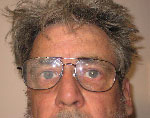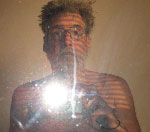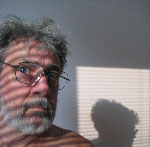
Thomas O'Flynn was born in Long Beach, California in 1946. He earned a degree in printmaking from California State University Long Beach, having studied with Dick Swift, Bob Evermon and Clinton Cline. After graduating in 1976, he travelled east at the behest of patrons in Boston. There, he met Agnes de Bethune, a fellow artist and future wife. Together, they travelled back and forth across the country numerous times. Despite all the moving around, they were able to maintain a steady and productive studio practice, and even, for a brief period, opened a small gallery in their storefront space, showing the work of other artists.
O'Flynn began to move away from the strictly 2-dimensional, first by introducing collage into his imagery, then more and larger found object elements. While in California, the artist participated in a number of group shows and juried exhibitions and one major museum show at the Long Beach Museum of Art in 1982. As the result of a fortuitous studio swap, he moved one last time across the country to New York. During the 80s and 90s, he showed mostly small assemblages and collages in a variety of group shows in and around New York, culminating in a solo retrospective which included a number of large wall pieces and sculptural works, at Chelsea Studio Gallery in December 1999.
He currently maintains studios in Jersey City and in Newport, Rhode Island.
from O'Flynn's 2000 retrospective Secrets of the Heart, Assemblage from the 90s
This is the first one-man show of the assemblages of Thomas O'Flynn in New York City; it offers a retrospective of the past ten years' work in a medium he has explored throughout his career. It is the first time his large scale works will be on public display; also included are five sculptural pieces which could be called free-standing assemblages. The 44 pieces in this show range from light-hearted whimsy to serious statements about the human condition.
The show is varied in theme & subject, but the voice is remarkably consistent throughout, with one device after another establishing this artist's particular vocabulary. There is, overall, an infatuation with the material of the physical world. Elegantly patinated surfaces of worn out objects that would ordinarily be consigned to the trash bucket combine with snippets and fragments of partially obscured text and occasional bits of the artist's own draftsmanship. As with poetry, these found objects inspire association. In the artist's own words:
Found objects offer a way to introduce random elements and things not of my hand into my art. I use these found things much as a poet uses words to create a feeling, an artistic situation, a personal expression.
Some of the pieces make reference to past and present practitioners of this method of artmaking: Braque, Cornell, Herms, Kienholz, Nevelson, Picasso, Rauschenberg, Schwitters. Red Giant is like a "rough" homage to Joseph Cornell in which a spattered and stained linoleum stands in for the usual astronomy; Wheel of my Youth contains "Braque-like" shapes against which the main figure is set; Mississippi Basin has small moments faintly reminiscent of Kienholz; and yet, this work is in no way derivative of any of these predecessors; it is entirely original.
The small and spare, but enormously funny Art History contains a spectrum of references to the female nude from the sly to the overt, ranging from a direct quotation of one of DeKooning's women to the barely intelligible calligraphy of accidental scratches on the surrounding panel that describe a female lower torso.
Modern life with its rampant technology, particularly in the entertainment and information sector, has given new meaning to the assembling of visual data. Visual images, thanks to digital photography and computers, are cut and pasted into a dreamlike world of impossibilities. What was once quite modern is now commonplace. The artist, in his use of disparate things in the work, creates a tension which is reformed and remodeled into a newness of being. This newness is not in the method of artmaking, which has been in use since the early 1900s, but in the way the viewer sees and acknowledges its validity in contemporary life.
In looking at this work, I am reminded of the statement in the foreword to
Art of Assemblage by William C. Seitz which quotes Margaret Miller.
Collage cannot be defined adequately as merely a technique of cutting and pasting, for its significance lies not in its technical eccentricity but in its relevance to two basic questions which have been raised by twentieth-century art: the nature of reality and the nature of painting itself. Collage has been the means through which the artist incorporates reality in the picture without imitating it.
This statement was written 60 years ago, in 1948. During the 1950s and 60s, Johns, Rauschenberg, Kienholz, Herms and others were changing how we would look at assemblages in their relationship to painting and sculpture. O'Flynn's work is in this tradition, but he has added the further dimension of the title as a verbal, poetic adjunct which is assimiliated into the visual and resonates with it to reinforce the artistic energies of the piece. The titles of the works are often key to understanding and appreciating O'Flynn's art.
It is fairly obvious that this artist is a prodigious student of history: cultural, political and natural; the allusions, in many cases, elucidate a personal vision of well-known events. Rommel in Africa vividly depicts forward motion across the desert sand in the face of relentless attrition and a desperate lack of fuel. With remarkable economy of means, it tells a story more poignant that any narrative or documentary could.
Other pieces are simply fantastic and imaginative musings in which cultural phenomena merge with the personal in a neat juxtaposition: Cargo Cult, an effigy of rust and sea rot, is a dreamy and somewhat frightening totem suggesting dangerous journeys to faraway places.
And yet some of this work expresses experience and memory in a way that makes it accessible to others; the celebratory Catherine Street shares a moment of O'Flynn's life in Chinatown; Surf City with its ebullient gestures is an icon of his teenage years.
This work does not preach a message, but it does ask you to consider humor, irony and folly amid the often overwhelmingly serious issues of human existence. In Secrets of the Heart, Assemblage from the 90s, random discards and rejects of ordinary life are saved and rendered into something quite mysterious and wonderful.
ARTIST'S STATEMENT
The visual artist's world relates to the whole of a person's experience, and is not necessarily a world only of pictures. My voice seems to be that of a visual artist and, in particular, one who makes assemblages instead of, say, paintings or sculptures.
Some of this work relates to my reading at the time and my reflections on history. Rommel in Africa and Heart of Darkness are examples. Heart of Darkness deals with the mysteries of Conrad's book and Coppola's movie Apocalypse Nowัthe horror of the unknown, the fear of the primitive world with all its casual violence and boredom, the early world of our ancestors, "going native", the greatest fear of the civilized world, especially in societies which are strictly regimented. Saigon is a piece I struggled with for years. I wanted to do an object about my experiences in the Viet Nam War. You know you can never get it right because it's too big a deal, but there is always an urge to try. It's a paradox because the only people who are ever going to get it are other soldiers; it's not a piece for an art audience. There is no message, just a memory of the things that happened and how I felt about them.
The titles, as a rule, support the art-objects by tying together the verbal and the visual. In some of the pieces, the title explains and references it. Examples of this are: Minotaur, Dionysus,The Canadian Shield, Plate Tectonics. Some are evocative and emotional, inspired by a mood or a feeling while others are highly specific as to a place or event. The titles are as much a part of the art making process as the images are.
Found objects give me a way to incorporate the real world into my imagined one.
Some make up stories to be thought about and to reflect on. Some are just the objects in and of themselves, recycled into a different form and purpose. There are times when the found things seem to want to be together and all I do is arrange them; they have been altered and changed from their orginal functions.The broken wheel now is a visual circle; the box, a mysterious container; the piece of sea-encrusted hose, a splash of color. By assembling and changing the orginal intent of the object, it can take on another life. Sometimes, it's what I want and, other times, what the objects want. But, always, the art is a platform to step off of, a different way to wander around one's own thoughts and ideas, a way to reflect on the nature of things. These objects are not for quick eyes; they change and redefine themselves in endless rounds of visual memory. The more one looks, the more one sees.
|


